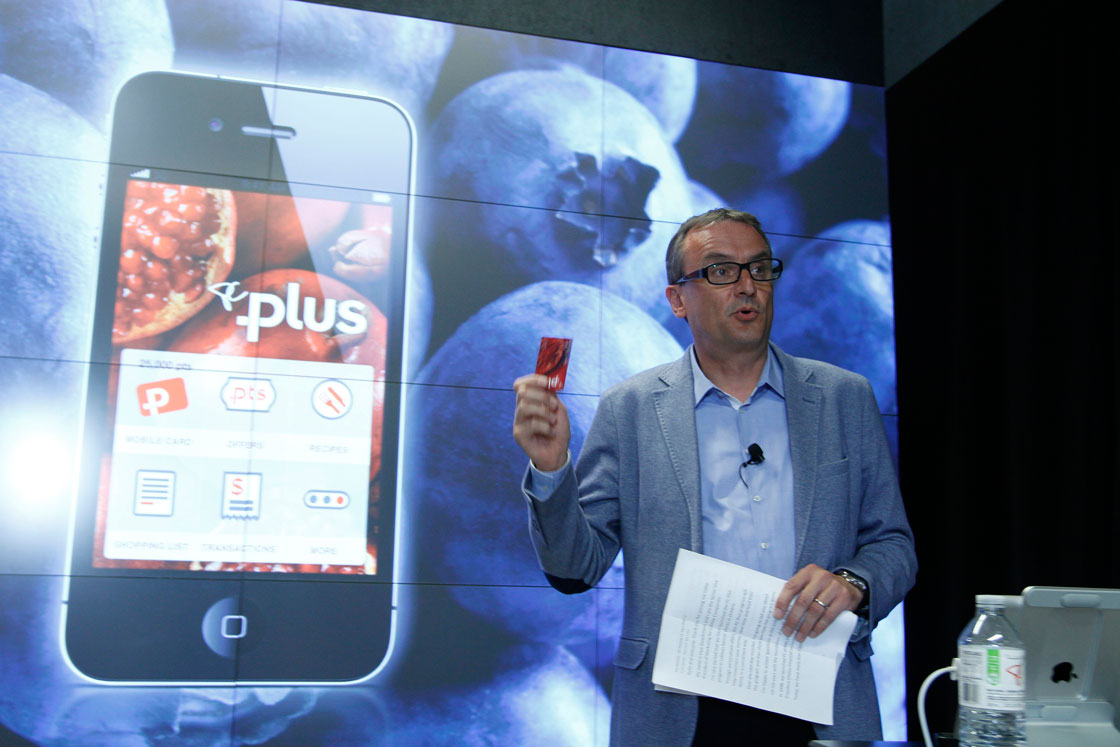Picture a busy Loblaws-owned super market, any one among the 2,300 or so across the country on a spring afternoon.

Haddock fillets aren’t moving as fast as the store manager would like. Loblaws’ inventory monitoring system realizes this, however, perhaps even before he does.
With a need to sell them rather than let them spoil, shoppers are alerted that there’s a sale over in the fish department.
But instead of an announcement crackling out over a PA system, members of PC Plus, Loblaws’ new loyalty program, are sent a push notification to their phones.
But not just any members in the store at the time – the ones most likely to buy haddock. “And at what price,” says Bob Elliott, a software executive.
Based on past choices, Joe in aisle 3 is offered the fish at $3.50 off the sticker price. Jane meanwhile receives a separate notification for $4.20 off.
That scenario isn’t quite here yet, but PC Plus, which was introduced nationally by the country’s largest grocery retailer last fall, is nearing such a shopping experience, experts say.
“Your imagination is probably the most limiting factor” when it comes conjuring up new sales tactics now being enabled by a new wave of technology-driven loyalty programs entering the retail landscape, Elliott says. “What’s been out there until now is horse and buggy.”
Elliott is the Canadian managing director for SAP, a German software giant that is the wizard behind the curtain.
For the past few years, Loblaw has been busy retooling its back-end systems using the German company’s software, putting in place end-to-end solutions to tightly wed the sprawling grocer’s vast inventory channels to its new customer loyalty program.
The aim is to reward shoppers using the same traditional points-for-cash system that is the hallmark of most loyalty programs today, but also serve up the right deals for the right products to the right customer at exactly the right time.
Loblaw believes sales will rise under the program, while costs on marketing (like the tens of millions spent annually on flyers) and spoiled food will fall.
Vicente Trius, Loblaws’ president, said Wednesday the program was “exceeding expectations.”
Opting in

Get weekly money news
But the program’s success hinges on shoppers’ willingness to opt in and fork over a colossal amount of information; each tiny decision made in store; the hour of the day a visit to the supermarket is made; how much time—and money—is spent, by product, by weight, by brand.
Everything, through an app on a phone or card scanned at the time of purchase, can be collected, stored, sifted through and then baked into a customer profile.
Since being rolled out nationally, two and a half million shoppers have registered, Loblaw said Wednesday. The grocer and retailer aims to attract 12.5 million more in the coming years.
Trius said data for 40 per cent of all purchases made at participating stores are now captured by the program.
And if Loblaws’ popular Optimum program at newly acquired Shoppers Drug Mart (another 10 million accounts) moves to a similar technology framework, the country’s largest retailer will have working files open on the shopping habits of tens of millions of Canadians.
So, should shoppers have any concerns?
“It depends on how the retailer uses the data,” Ken Wong, a marketing and business strategy professor at Queen’s University, said.
“Consumers have no problems sharing data if, number one, they think the data is going to be maintained in confidence, and number two, it will result in a positive gain for them.”
There’s little debate about whether or not the digital analytics behind PC Plus are capable of delivering timely and relevant information to shoppers.
On the matter of confidential treatment of that information, experts suggest there’s little to worry about, as well – at least in the realm of proprietary loyalty programs where there isn’t overly sensitive information collected and stored, such as credit-card or bank account numbers. At least not yet.
“I think there’s always people that have privacy concerns,” he said, and in this instance, “maybe falsely.”
Sol Zia, founder of Loyalty Engine, a startup that provides software solutions to retailers, said big retailers typically aren’t in the business of sharing personalized data either.
“There’s a myth that retailers are sharing data with third parties and there’s these big brother databases out there aggregating individual data,” Zia said. “I think that’s a myth.”
Still, language used by Loblaw, which did not respond to request for comment, isn’t exactly reassuring.
“Sharing of data will only occur in a manner consistent with the privacy policies of each company and applicable law,” Loblaws said following the approval by competition regulators of its $12.4-billion purchase of Shoppers last year.
Prof. Wong says retailers using their own proprietary programs are doing so to get an edge over competitors and would keep that information close to their chest.
“These programs are a huge component of their marketing strategy. They represent tens of millions of dollars in value,” Wong said. “You would not sell that.”
Zia says third-party marketers sometimes purchase aggregated data from sources such as retail loyalty programs. But “From my experience, no one is sharing information at a personal level.”
Still, discount retailer Target drew flak in the United States after a report revealed that its customer tracking practices had figured out that a teen girl was pregnant before her father found out, in part by using data acquired from other sources.
The company hadn’t broke any laws, but as Andrew Pole, one of Target’s analytics wiz kids put it: “Even if you’re following the law, you can do things where people get queasy.”
The report was published as Target was preparing to jump feet first into Canada, a move that’s forced the country’s incumbent retailers to sharpen their games and adapt to the new order.
WATCH: Grocery trends









Comments